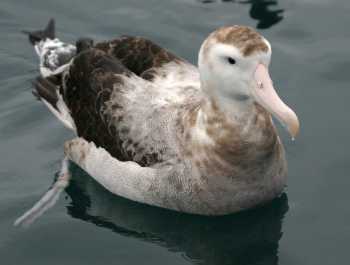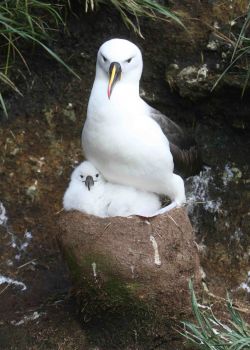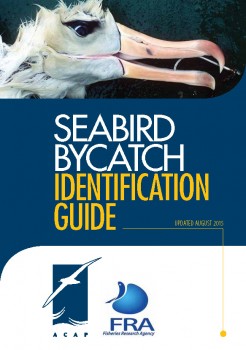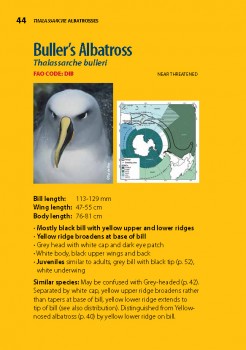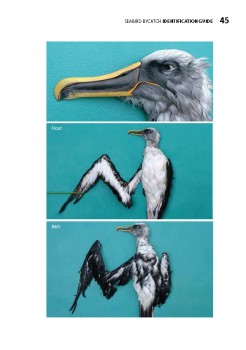Top (10.6 ha) and Bottom (5.7 ha) Islands lie close together near the entrance to Port William in East Falkland in the Falkland Islands (Islas Malvinas)*, three quarters of a kilometre off the Cape Pembroke coastline. Both islands are covered in Tussac Grass Parodiochloa flabellata.

Top Island from the air, photograph by Nick Rendell

Bottom Island, photograph by Nick Rendell
The presence of ACAP-listed White-chinned Petrels Procellaria aequinoctialis was first reported on Top Island in 2001. Although visited and searched in 2005, no White-chins were then found breeding on Top Island. Breeding was confirmed on Bottom Island in 2005, although birds had previously been recorded calling while flying over the island in 2003. Two occupied White-chinned Petrel burrows found on Bottom Island in 2005 had “broad, wet entrances and positioning very similar to the burrows on Kidney Island”.
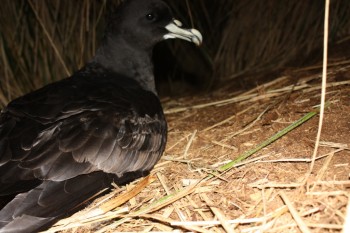
White-chinned Petrel amomng the Tussac on Top Island, photograph by Kalinka Rexer-Huber
Visits under permit were made in October 2012 to both islands to survey for burrowing petrels. White-chinned Petrels were found to be breeding on both islands, with the total breeding population likely to be of the order of tens rather than hundreds of pairs on Top but perhaps more on Bottom. More accurate estimates were not feasible due to the difficulties encountered separating White-chin burrows from those of Magellanic Penguins Spheniscus magellanicus without the use of playback or burrowscope in the breeding season.
Sooty Shearwaters Puffinus griseus were first reported breeding on Top and Bottom Islands in 2001. In 2012 it was estimated there were 8300 burrows of this species on Bottom Island and c. 18 000 on Top Island. Grey-backed Storm Petrels Garrodia nereis may breed on Top Island based on a few small burrows found in 2012.
In September 2001 Norway or Brown Rats Rattus norvegicus were eradicated from Top and Bottom Islands by ground baiting. Confirmation they had remained rat free came in 2009 and 2012 following site visits, with some evidence that the numbers of burrowing shearwaters had increased by 2012 as a consequence.
The two islands are Crown Land and have been proposed for inclusion in the National Nature Reserve (and the Important Bird Area – IBA) of Kidney and Cochon Islands. A management plan for Kidney Island, Cochon Island and Top and Bottom Islands is currently under review.
White-chinned Petrels are known to breed at only two other localities in the Falkland Islands (Islas Malvinas)*: Kidney and New Islands.
With thanks to Clare Cockwell, Nick Rendell and Kalinka Rexer-Huber for information and photographs.
Selected Literature:
Brown, D. & Chadderton, L. 2001. Investigation of the Potential for Rat Eradication in the Falkland Islands. Report on Preliminary Visit, 27 Jan - 3 March 2001. Unpublished report to Falklands Conservation. 32 pp.
Brown, D., Chadderton, L. & Brown, K. 2001. Report on the Falkland Conservation Rat Eradication Project August -– October 2001. Unpublished report to Falklands Conservation. 22 pp.
Poncet, S., Passfield, K. & Rexer-Huber, K. 2012. Burrowing Petrel Surveys: Top and Bottom Islands and Tussac Point in Port William and Sophie and Amy Islands in Port Pleasant. Stanley: Beaver Island LandCare. 15 pp.
Reid, T.A., Lecoq, M. & Catry, P. 2007. The White-chinned Petrel Procellaria aequinoctialis population of the Falkland Islands. Marine Ornithology 35: 57-60.
Wolfaardt, A.[C.], Rendell, N. & Brickle, P. 2010. Falkland Islands Implementation Plan for the Agreement on the Conservation of Albatrosses and Petrels (ACAP): Review of Current Work and a Prioritised Work Programme for the Future. Stanley: Falkland Islands Government. 57 pp.
John Cooper, ACAP Information Officer, 26 August 2015
*A dispute exists between the Governments of Argentina and the United Kingdom of Great Britain and Northern Ireland concerning sovereignty over the Falkland Islands (Islas Malvinas), South Georgia and the South Sandwich Islands (Islas Georgias del Sur y Islas Sandwich del Sur) and the surrounding maritime areas.
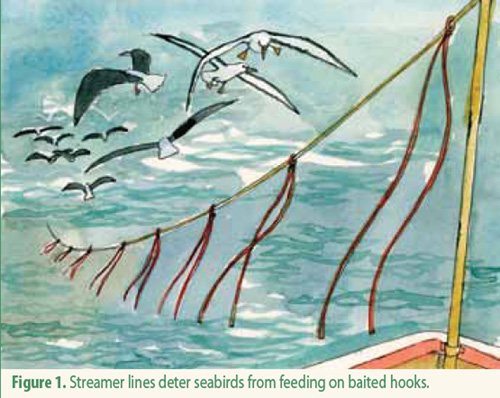

 English
English  Français
Français  Español
Español 